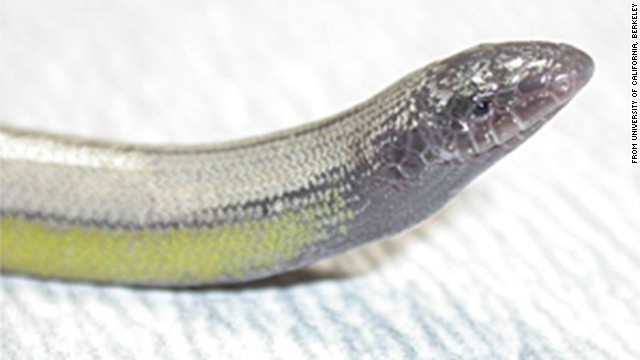updated 9:22 PM EDT, Thu September 19, 2013

STORY HIGHLIGHTS
- One species lives in dunes near Los Angeles International Airport
- Another found in vacant lot in Bakersfield, California
- Legless lizards live in ground, don't move very far
- Amphibian expert: "There is a lot of undocumented biodiversity within California"
They are yellow-bellied legless lizards, and their species name is A. stebbinsi, after 98-year-old herpetologist Robert C. Stebbins. Their home is in the dunes west of Los Angeles International Airport.
Stebbins' namesakes,
which look like snakes, were discovered and identified by Theodore
Papenfuss, a herpetologist with the Museum of Vertebrate Zoology at the
University of California, Berkeley, and James Parham of California State
University, Fullerton.
The pair also reported finding three other new species of legless lizards, all from California, in research published this week in the journal Breviora from the Museum of Comparative Zoology at Harvard University.
The other legless lizards
were found among oil derricks in the San Joaquin Valley, on the edge of
the Mojave Desert and in a vacant lot in downtown Bakersfield.
"These are animals that
have existed in the San Joaquin Valley, separate from any other species,
for millions of years, completely unknown," Parham said in a statement
from UC Berkeley.
Papenfuss said, "This shows that there is a lot of undocumented biodiversity within California."
Undocumented because it's
hard to find, at least in the case of these lizards. They burrow into
the loose soil and spend their entire lives in an area measured in
square feet.
The A.
stebbinsi were found under leaf litter. The three other species -- the
silver-bellied A. alexanderae, the purple-bellied A. grinnelli and the
yellow-bellied A. campi -- were found after researchers left flattened
cardboard boxes and pieces of plywood in areas where they suspected the
lizards might live, then went back to see if the critters took up
residence underneath.
And this was no quick
study. The specimens were collected over a 14-year period, the
researchers said. In fact, the researchers reported that all of the
species were actually in collections and stored in alcohol.
The alcohol, however,
removed coloring so scientists had to do genetic testing to confirm that
those specimens were part of the previously unidentified species.
The four new species
bring to five the number of known legless lizard species in California.
The previously identified common legless lizard of Northern California
looks like the A. stebbinsi, and the two can only be distinguished by
genetic testing, the researchers said.
There are more than 200 species of legless lizards worldwide, they said.
And you must be wondering how to tell a legless lizard from a snake.
According to the Natural History Museum of Los Angeles County, the easiest way to tell the difference is to look them in the eyes. If they blink, they're lizards. If not, they're snakes. That's because lizards have eyelids and snakes don't.

No comments:
Post a Comment